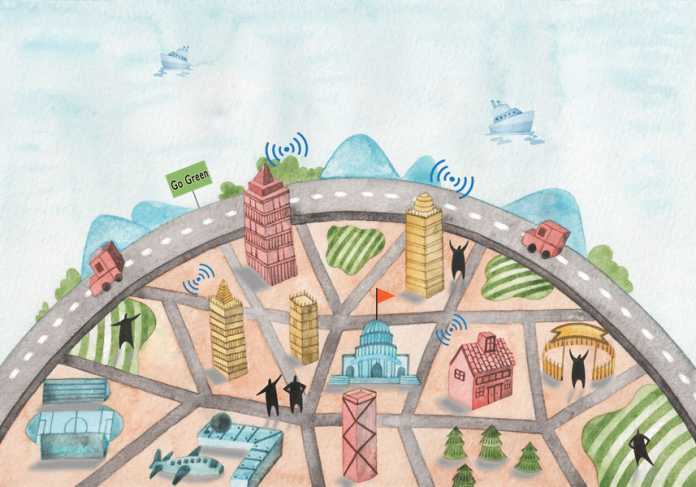By Joan Enric Ricart, Pascual Berrone, Juan Manuel Barrionuevo & Asun Cano Escoriaza
Urban areas are facing great challenges as their socio-economic environments constantly change, their population increases and the competition with other urban areas strengthens. In order to respond to these challenges, cities need better governance and thus better implementation strategies if they want to prosper.. The authors argue that urban strategies can be made more efficient if the six levers of change are taken into account. Adopting this “smart governance” approach can help cities in the implementation of their path towards success.
In this new century, a new approach to technology and the benefits of its deployment in cities has opened a path towards the so-called smart cities. However, in order to maximise the benefits of technology, a good strategic planning is required with a clear future vision, linking cities, enterprises and citizens. The challenge is to mix technology and smart governance to work towards real smart cities which should consider not only technology but some other important elements.
Cities, when properly planned and managed, hold the promise for human development and the protection of the world’s natural resources through their ability to support large numbers of people while limiting their impact on the natural environment.1 But urban areas are facing increasing challenges as their socio-economic environments constantly change, urban population increases and competition with other urban areas to attract talented citizens, organisations and investors intensifies.
At IESE Cities in Motion Strategies research platform, an initiative that has been developed by the Centre for Globalisation and Strategy and the Department of Strategic Management at IESE Business School, we encourage cities to work towards a smarter city by giving city managers better frameworks for strategy formulation and execution. We believe that a city could be called smart if it fulfils four conditions: Sustainable, Connected, Innovative, and Equitable.
Sustainable means that the city has an appropriate population density; housing is not dispersed in order not to increase the need of private transport. Additionally, the growth of the city is organised and thought out; the main population centres are not very far away and there should be public spaces and parks where citizens can live together and enjoy nature and children can play. City halls work towards energy efficient cities where natural resources and waste are well managed.
Connected means that the city promotes an efficient mobility and inter-modality; pedestrians can walk easily and bikes are ridden with the same rights as cars have. Habitants are well connected through generalised access to internet. Connectivity is also extended globally in order to link cities with other distant urban centres.
Innovative implies that the city promotes creative activities and tries to manage, develop, stimulate, and attract talent. Innovative cities promote a suitable environment for entrepreneurship, support the development of the private sector and use technology to make the city smarter. Equitable means that the city promotes social cohesion among citizens, creating opportunities for all. Diversity is valued and enhanced but at the same time the city shares a common identity and collective values. In an equitable city the local government takes into account the opinions of the citizens and shares with them its policies and management data. Citizens’ security is guaranteed, as well as health and education; each citizen should as well be able to find the option that best suits her needs thanks to public-private cooperation.
Towards Better Governance Metropolitan regions have grown a lot in size and complexity during the past 150 years but still lack mechanisms for addressing the multidisciplinary issues of sustainable development; they need better governance structures to be able to take a global vision in decision-making. The city needs to reflect on how smart governance – strategies, policies, processes and frameworks- can help local administrators work with a more strategic vision to improve the quality of life of their citizens. Smart governance searches for flexibility and multilevel relationships to make cities more resilient and adaptable to change. The only way cities can meet the challenges of the twenty-first century is with an accountable and fair governance structure that delivers effective and efficient public services2. Good governance allows citizens to use their talents fully; it can mark the difference between a well-managed and inclusive city and one that is not3.
Governance can be understood as a mechanism that tries to empower citizens and make decision-making more transparent4, as a process that coordinates public and private interests5 and as the process of delivering government through the inclusion of non-government actors6. Governance comprises the mechanisms, processes and institutions through which citizens and groups articulate their interests, exercise their legal rights, meet their obligations and mediate their differences7.
For example, when the city hall of Santander (Spain) decided to develop a strategic plan, the municipal sustainability board –made up of people from political, social, economic and environmental settings- supervised the documents that were developed. The main social and economic agents of the city were present in the Board, whose main responsibilities were to write reports and suggestions about local economic development, strategic city planning and important projects for the city. Similarly, the PlaNYC for New York City appointed a Sustainability Advisory Board with seventeen experts representing business, labour, environmental advocates and planners.
The UN characterises good urban governance with the principles of sustainability (cities must balance the social, economic, and environmental needs of present and future generations), subsidiarity (responsibility for service provision should be allocated at the closest appropriate level consistent with efficient and cost-effective delivery of services), equity, efficiency, transparency and accountability, civic engagement, and citizenship (citizens must actively contribute to the common good through participatory decision-making processes, neighbourhood advisory committees, citizen’s forums, city consultations, participatory strategy development…) and security; they are interdependent and mutually reinforcing8.
It is important to distinguish between the concepts of governance and government. Governance is conceptually broader than government because it recognises that power exists inside and outside the formal authority and institutions of government. Governance normally recognises government, civil society and the private sector as the key actors (at the local level central government, state or provincial government, local authorities, non-governmental organisations, community-based organisations and the private sector can be taken into account)9. Additionally, governance is broader than management because it encompasses mechanisms and processes of administration, management and implementation.10
Implementing Smarter Cities: The Six Levers of Change
Local governments should work towards smarter cities, cities that are sustainable, connected, innovative and equitable. But, how can local governments formulate and, especially, implement smarter strategies? What implementation mechanisms could they use towards smarter governance at the city level?
The following six levers of change can help urban leaders to implement the smarter city that they want. We suggest that there are 6 leverages that can be catalyst in achieving more innovative, cohesive, connected and sustainable cities.
Strategic and scenario planning: Cities need to analyse their strengths, weaknesses, opportunities and threats around these ten conditions, what we call the ten Cities in Motion conditions:
• Economy: This factor refers to all those aspects that promote the local economic development of a city. Urban leaders must analyse macroeconomics of their urban area, the local economy, local economic plans, economic transition plans, industry strategic plans, clusters, innovation and entrepreneurship, diversification, employment, investment and investors…
• People: This point refers to local human capital; talent, education, skills, creativity; research and development, educational institutions…
• Environment: Anti-pollution plans (noise, air, light…), environmental quality, energy, climate change policies, waste management, green areas and parks…
• Social cohesion: The local social environment deals with immigration, community development actions, efficiency of the health system, senior citizens, state of public safety, shared identity, common values, equality of opportunity and opportunities for all…
• Urban planning: This point should try to ensure the liveability of the territory; local master plans, public spaces, green design and smart growth (new urbanism focusing on compacted cities with high connectivity and easy access to public services) should be analysed.
• Governance: This point analyses the degree of participation and involvement of citizens, distribution of power, organisational structure, e-government plans, capacity to engage business leaders and local agents, public-private partnerships, collaboration and communication….
• Public Management: Efficiency of the local administration, methods to assign the best resources to the key tasks, organisational models to deliver greater value to citizens, innovation management plans, management models, frameworks to direct decision making towards smarter cities (include sustainability, social cohesion, innovation and connectivity in decision making).
• Technology: Analysis of the degree of technological connectivity within the city: ICT technologies, free Wi-Fi hot spots, technological education…
• Mobility and transportation: Internal and external connectivity, public transportation, access to public services, congestion, international transportation infrastructure (airports, ports, railways…)
International capital: Factors that increase the international brand and recognition of the city overseas: tourism strategic plans, city diplomacy, international city branding and positioning, attraction of foreign investment…
Through the analysis of these 10 key elements, the city understands its current situation, identifies its competitive situation and strategic position, checks the maturity stage of its urban model (in terms of sustainability, social cohesion, innovation and connectivity), defines a long-term strategic vision and is capable of redesigning how it will grow and progress in the future.
Apart from long-term strategic planning, cities should think about future economic, social, territorial, environmental scenarios that project the city that they would like to achieve. These scenarios are the objective to achieve with the strategic plan. Global urban indicators and benchmarking of international best practices can help cities in the planning task.
Collaboration and communication: Collaboration and communication is needed not only within the city but also with other cities.
Within the city, stakeholders must be invited to participate in the process because every contribution matters to achieve smarter cities; civic organisations, public bodies, government institutions, universities, business experts, research centres and citizens in general should be invited to take part in strategic reflection and action. Regular communication with the different actors should be established to better identify the needs of the city and its stakeholders, get local actors on board, set common goals, increase learning opportunities, improve transparency and implement more inclusive public policies. For example, in the Netherlands a new smart phone application –Nulpunt- is making government information not only accessible but useable and navigable; it enables citizens to register, indicate their areas of interest and then receive the information. Following the European Union, local governments should work towards a “negotiated city” that brings together apparently opposing values and visions, merge top-down with bottom-up approaches and transform cities into shared spaces.
External collaboration and cooperation with other cities should be encouraged in public services, large development projects, knowledge infrastructure and transport; the European Union advocates cities in neighbouring territories to engage in cooperative competition. Following the European Union, we think that the main challenge for coopetition among cities is to develop a strategic process of thinking, planning, and acting creatively and differently but at the same time work together towards a sustainable future. Cities should make the most of collaboration programs such as URBACT, which encourages European cities to cooperate and learn together about topics related to innovation and creativity, quality sustainable living, active inclusion, culture, human capital and entrepreneurship, urban renewal, disadvantaged neighbourhoods, low carbon urban environments, metropolitan governance… Additionally, cities can also benefit from European Groupings for Territorial Cooperation (EGTC), a European legal instrument designed to facilitate cross-border, transnational and inter-regional cooperation; it enables the public authorities of different member states to deliver joint services11.
The most effective city strategies are based on participation and involvement of key stakeholders of the city; they promote citizens’ ownership of the city, take advantage of the distinctiveness of place and unique advantages of the city, align the urban mission with the national goals and disseminate coherent messages for the different audiences (United Cities and Local Governments, 2010).
Public-private partnerships: They can be beneficial for both, the public and the private sector. For the public sector, they can result in significant savings and can be a way to learn. The private sector can gain greater government cooperation and a better understanding of local needs through these partnerships, raise its international visibility and, consequently, access new business opportunities and talent.
For example, the city of Boston asked IBM to establish a framework that would provide policymakers, administrators, researchers and citizens with information related to historic, current and future transportation trends and options, to reduce traffic congestion and generate new ways to monitor levels of greenhouse gas emissions12. Transportation is responsible for about one quarter of Boston’s greenhouse gas emissions, and this initiative supports the City’s goal to reduce these emissions 25 percent by 202013.
Funding strategies: Local governments should work to find ways to increase revenues without creating dissatisfaction among citizens, reduce costs and obtain greater funds to promote new projects through innovative revenue lines. For example, neighbor.ly, a civic crowdfunding platform, provides a unique opportunity for local governments, civic organisations, and civic ventures, to obtain funding for civic-natured projects. On the other hand, social impact bonds are a promising new approach to government financing of social service programs; pay-for-success contracts using social impact bonds have the potential to improve results, overcome barriers to social innovation and encourage investments in cost-saving preventive services14. Innovative business models could also help city halls in finding new funding strategies; for example Gowex, which leads the creation of WiFi cities15. Gowex develops a sustainable business model in the WiFi networks, which benefits the city council, users, franchises, associations and carriers.
Technological infrastructure: Information and Communication Technologies (ICT) is an essential driver of a community’s economic and social development. Cities have progressed a lot on installing urban sensors to control irrigation in green areas or to show citizens which parking lots are free at a given moment of time, but technologies should also be used towards more strategic objectives; they could be very helpful to achieve a smarter city depending on the percentage of inhabitants that are using mobile-based local service applications. Local governments should constantly think what technologies could be implemented to create value for the city.
Capacity management / management skills: Local governments need to assign the best resources to the key tasks and manage the urban area by creating shared value for all stakeholders, especially for citizens. Project management and performance management can help local governments in this task, as well as the creation of a municipal performance office. The urban model that the IESE Cities in Motion Strategies Platform encourages city halls to use when taking strategic decisions for the city, the Platform’s strategic and management frameworks that facilitate city managers’ decision making, strategy design and execution, should help to achieve smarter cities; more innovative, sustainable, connected and cohesive cities. The six levers of change that are presently being described could be very helpful in the implementation of the strategy to achieve a smarter city.
Real smart cities are those cities not only considering technology and its implementation in order to face their challenges. Only through a careful assessment of the current situation of the city, a careful planning and a well-considered strategy, and the 6 leverage of change in place, a smart city will be attainable.
For more information about the IESE Cities in Motion Strategies Platform, you can visit: http://www.iese.edu/en/faculty-research/research-centers/cgs/cities-motion-strategies/ (February 2013)
About the Authors
Professor Joan E. Ricart is academic co-director of the IESE Cities in Motion Strategies platform, director of the Strategic Management Department and holder of the Carl Schroeder Chair of Strategic Management at IESE. Besides serving as the vice president of the Iberoamerican Academy of Management, he was the founding president of the European Academy of Management and also presided over the Strategic Management Society. His research focuses on business models, offshoring, corporate governance and sustainable development.
Professor Pascual Berrone is academic co-director of the IESE Cities in Motion Strategies platform, assistant professor of strategic management at IESE and vice president of the Iberoamerican Academy of Management. Holder of a Ph.D. in business administration and quantitative methods from Carlos III University in Madrid, he has extensive experience in American and European firms. His research focuses on corporate governance, executive compensation, family business, sustainable innovation and corporate social responsibility. Juan M. Barrionuevo is director of strategy at Mobile World Capital and president of the advisory council / founders club of the IESE Cities in Motion Strategies platform. He has more than 15 years of experience in the ICT industry, as well as a background in entrepreneurship, both as a business angel and as a creator of venture capital networks. Asun Cano Escoriazais a research assistant at IESE Business School. Previously, she carried out graduate studies in Harvard University and London School of Economics & Political Science (LSE). She has worked in management consulting, as well as in several non-profit organizations on issues related to CSR, sustainability and economic sociology. She has also been adjunct professor at the University of Zaragoza, where she studied a Bachelor in Business Administration and Management.
References
1. UN (2002): Global campaign o.n urban governance concept paper”, 2nd edition, UN Human Settlements Programme, March 5
2. Fuchs, E. R. (2012): “Governing the twenty-first century city”, Journal of International Affairs, Spring/Summer, Vol. 65, No. 2
3. UN (2002): Global campaign on urban governance concept paper”, 2nd edition, UN Human Settlements Programme, March 5
4. Carreras, I., Puiggròs, A. and A. Rodríguez-Pose (2012): “Las tendencias mundiales y sus impactos en las grandes metrópolis”, Plan Estratégico Metropolitano de Barcelona, January
5. Pierre, J. (1999): “Models of urban governance: the institutional dimension of urban politics”, Urban Affairs Review 34
6. Jones, P. and J. Evans (2006): “Urban regeneration, governance and the state: exploring notions of distance and proximity”, Urban Studies, 43 (9) Werna, E., Keivani, R., and D. Murphy (2009): “Corporate social responsibility and urban development in the cities of the south”, Basingstoke: Palgrave
7. UN (2004): “Urban Governance Index. Conceptual foundation and field test report”, Global Urban Observatory, August
8. UN (2002): Global campaign on urban governance concept paper”, 2nd edition, UN Human Settlements Programme, March 5
9. UN (2004): “Urban Governance Index. Conceptual foundation and field test report”, Global Urban Observatory, August
10. Ibid.
11. European Union (2011): “Cities of tomorrow – challenges, visions, ways forward”, European Union Regional Policy, October
12. http://smartercitieschallenge.org/index.html (26 February 2013)
13. Ibid.
14. http://hks-siblab.org/about-us/ (26 February 2013) 15. http://www.gowex.com/en/about-gowex/about-us/ (26 February 2013)






























































